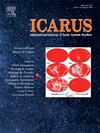Photochemistry of benzene (C6H6) hydrogen cyanide (HCN) co-condensed ices part 2: Formation of aerosols analogues of titan's atmosphere
IF 3
2区 物理与天体物理
Q2 ASTRONOMY & ASTROPHYSICS
引用次数: 0
Abstract
This experimental work has been carried out to characterize the nature of the aerosols analogues of Titan's atmosphere produced by the FUV irradiation of various C6H6:HCN co-condensed ices. Using infrared spectroscopy, in the spectral region probed by VIMS (Visual and Infrared Mapping Spectrometer), C6H6:HCN residues show some similarities with those of aerosols present in the Titan stratosphere. In addition, some spectral features in the range covered by the CIRS (Composite InfraRed Spectrometer) instrument support the greater similarity of C6H6:HCN residues with Titan's stratospheric haze than with the pure C6H6 residues. GC–MS (Gas Chromatography-Mass Spectrometry) analysis of the soluble fraction of C6H6-HCN residues shows that they are composed of polyphenyl aromatic rings and benzonitrile derivatives. These initial data allow us to probe the complexity of the residues produced by the photochemical aging process that co-condensed C6H6:HCN ices could undergo. They also provide a first overview into the structures that could be produced by these processes and which could be potentially detected on Titan‘s surface after sedimentation, during the future Dragonfly space mission.
苯(C6H6)氰化氢(HCN)共冷凝冰的光化学。第2部分:类似土卫六大气的气溶胶的形成
本实验工作是为了描述各种C6H6:HCN共凝冰在紫外辐射下产生的土卫六大气气溶胶类似物的性质。利用红外光谱分析,在VIMS探测的光谱区,C6H6:HCN残留物与土卫六平流层中存在的气溶胶具有一定的相似性。此外,在CIRS(复合红外光谱仪)仪器覆盖范围内的一些光谱特征支持C6H6:HCN残留物与土卫六平流层雾霾的相似性大于与纯C6H6残留物的相似性。GC-MS(气相色谱-质谱)分析表明,C6H6-HCN残基的可溶部分由多苯基芳香环和苯腈衍生物组成。这些初始数据使我们能够探测由共缩合C6H6:HCN冰可能经历的光化学老化过程产生的残留物的复杂性。它们还提供了对这些过程可能产生的结构的第一次概述,这些结构可能在未来的蜻蜓太空任务中在沉积后的土卫六表面上被探测到。
本文章由计算机程序翻译,如有差异,请以英文原文为准。
求助全文
约1分钟内获得全文
求助全文
来源期刊

Icarus
地学天文-天文与天体物理
CiteScore
6.30
自引率
18.80%
发文量
356
审稿时长
2-4 weeks
期刊介绍:
Icarus is devoted to the publication of original contributions in the field of Solar System studies. Manuscripts reporting the results of new research - observational, experimental, or theoretical - concerning the astronomy, geology, meteorology, physics, chemistry, biology, and other scientific aspects of our Solar System or extrasolar systems are welcome. The journal generally does not publish papers devoted exclusively to the Sun, the Earth, celestial mechanics, meteoritics, or astrophysics. Icarus does not publish papers that provide "improved" versions of Bode''s law, or other numerical relations, without a sound physical basis. Icarus does not publish meeting announcements or general notices. Reviews, historical papers, and manuscripts describing spacecraft instrumentation may be considered, but only with prior approval of the editor. An entire issue of the journal is occasionally devoted to a single subject, usually arising from a conference on the same topic. The language of publication is English. American or British usage is accepted, but not a mixture of these.
 求助内容:
求助内容: 应助结果提醒方式:
应助结果提醒方式:


